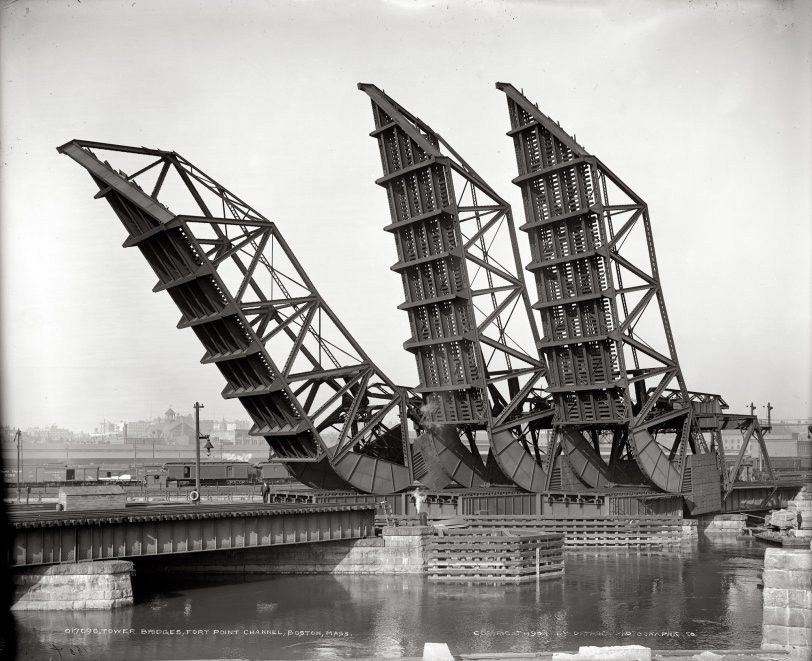


Framed or unframed, desk size to sofa size, printed by us in Arizona and Alabama since 2007. Explore now.
Shorpy is funded by you. Patreon contributors get an ad-free experience.
Learn more.

- Baldwin 62303
- Baldwin VO-1000
- Cold
- No expense spared
- Tough Guys
- Lost in Toyland
- And without gloves
- If I were a blindfolded time traveler
- Smoke Consumer Also Cooks
- Oh that stove!
- Possibly still there?
- What?!?
- $100 Reward
- Freeze Frame
- Texas Flyer wanted
- Just a Year Too Soon
- WWII -- Replacing men with women at the railroad crossing.
- Yes, Icing
- You kids drive me nuts!
- NOT An Easy Job
- I wonder
- Just add window boxes
- Icing Platform?
- Indiana Harbor Belt abides
- Freezing haze
- Corrections (for those who care)
- C&NW at Nelson
- Fallen Flags
- A dangerous job made worse
- Water Stop
Print Emporium
Boston Bridges: 1904

"Tower bridges, Fort Point Channel, Boston, 1904." Spans for Northern Avenue, Congress Street and Summer Street. Detroit Publishing Co. View full size.
Fort Point Channel Bridge
That is a gorgeous photo of the Old Colony Fort Point Channel Bridge! I've never seen a picture before of how it was when it was functional. Here is how I remember it, how it looked before it was torn down to make way for the Big Dig:
South Station
These are Scherzer Rolling Lift RR bridges at the approach to South Station, Boston. The advantage of the Scherzer is that it rolled back away from the channel to provide unlimited overhead clearance ("air draft").
Note the oversize gear teeth in the rollers + supporting track to keep them aligned as they rolled.
It appears they were raised all the way here just for the photographer, as indicated by the executive looking guy.
Search for "The Mechanical Equipment of the New South Station, Boston, Mass" in Google Books (the actual URL is way too long), scroll down to page 482.
Fort Point Channel bridges
I love this picture. Such wonderful shapes up against a featureless sky. I'm pretty certain, however, that these bridges aren't the Summer St, Congress St, and Northern Avenue bridges. I work in the Fort Point district and walk across the Summer Street bridge twice a day (the wind across that bridge is incredible, by the way. Whips right through you.)
A view of the channel today shows Summer, Congress and Northern quite far apart from each other (Seaport Boulevard is a brand-new bridge and was built after the Northern Ave swing bridge was fixed in place.) Only the Congress Street bridge is a bascule, and the Summer Street bridge is a unique retractile bridge, in that both of its spans used to slide out diagonally on narrow-gauge railroad tracks (which you can see on the left-hand side of the bridge.) None of these bridges are operating; in fact, the city is in the process of renovating the Congress Street bridge and just in the past year took out the gigantic concrete counterweights which used to hang above the roadway. Always got the heebie-jeebies walking under that thing.
I'm willing to bet these three bridges were located further south down the channel, and probably served the South Station train yards (I see quite a deal of boxcars in the distance.) In fact, I bet one of these bridges now serves as that piece of public art linked up in the first comment. I've seen it before and know that it was from a bascule that existed at that very spot before the Big Dig and the changes to the area.
At any rate, no matter where these bridges existed, they looked wonderful when they did.
Swinging Bridge
The Northern Avenue swing bridge was built in 1908, and still stands today.
A 1925 picture:
http://www.curp.neu.edu/sitearchive/spotlight.asp?id=2388
Were these bridges located between the current Congress and Summer St bridges?
O&W Guy
It doesn't say anything about R/R or vehicle traffic. I fished off these bridges as a boy and they were used for both.
Boat
Too bad we can't see more of the boat other than the 'scape pipes and stack and possibly the name board. What was the name or is it too fuzzy to read?
[Valora. - Dave]
Bascule bridges
The photo seems to have been mislabled as these bascule bridges are clearly not for vehicle traffic, but rather for rail use. The ties as well as guard rails that are parallel to interior of the running rails are clearly visible. Normally, the counterbalance weights on bascule bridges are suspended above the vehicle roadway, but given the vertical clearance required for early 20th century rail traffic, these weights have been arrayed outboard of the trusswork. Operationally, most rail bridges like these are left in an open position and closed only when rail traffic is scheduled. That will account for the fact that the small boat passing under these spans appeared to have sufficient clearance without the necessity of having to raise the spans. Finally, it is very common for rail bascule bridges to have their far end angled as these have been. The reason being that track alignment is much safer when one rail is longer than the other.
























On Shorpy:
Today’s Top 5